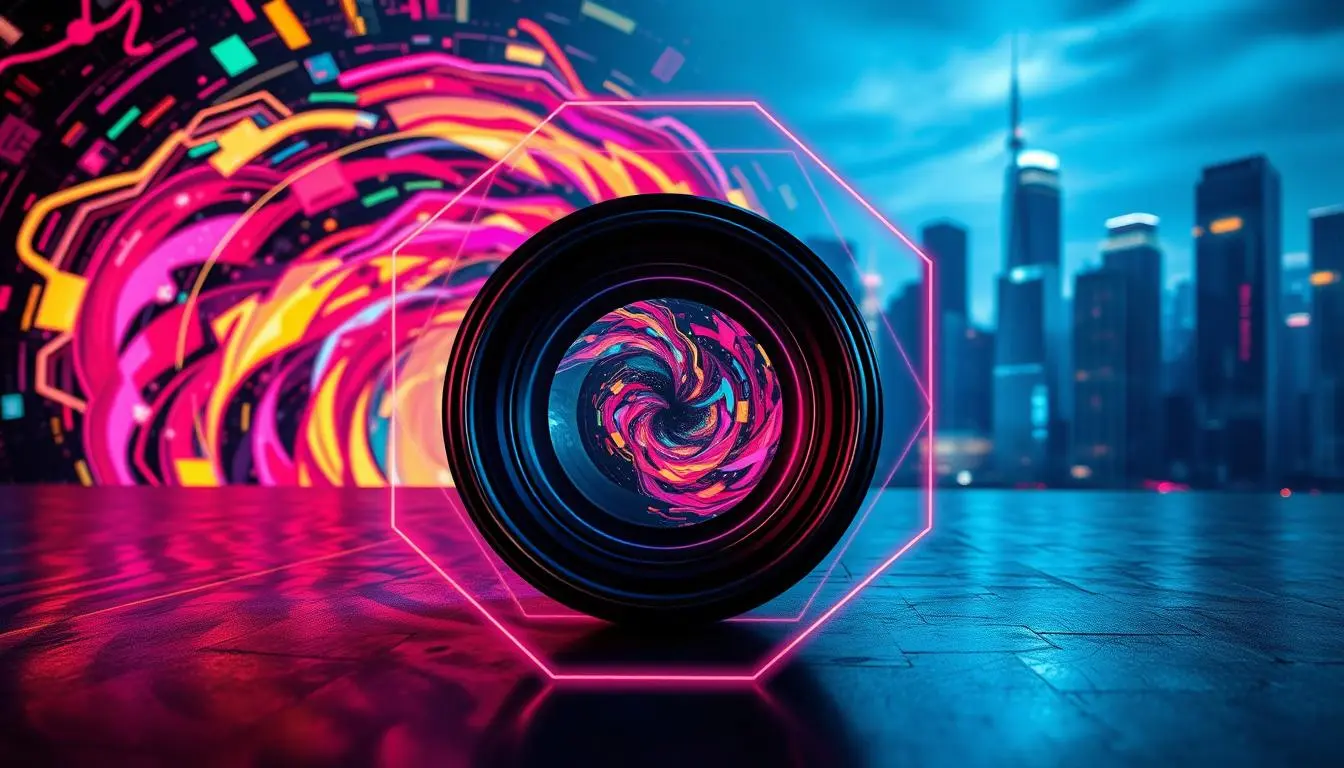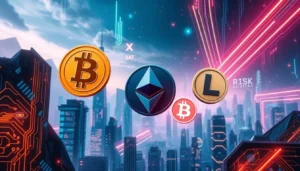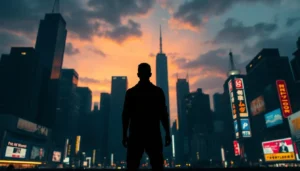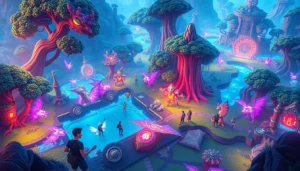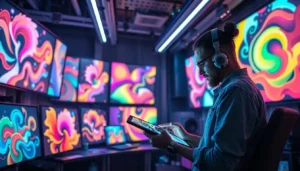NFT Photography: A New Era for Digital Photographers
The pace of global change is accelerating, and the creative landscape is evolving right alongside it. You might know that digital art is getting a big boost with non-fungible tokens.
This new tech lets digital photographers show and sell their work in a new way. With NFT photography, you’re not just selling a print. You’re offering a distinctive digital artwork, secured and verified through blockchain technology.

This new era is full of chances. It’s important for digital photographers to understand these chances to keep up.
Table of Contents
What Are NFTs and Why Do They Matter to Photographers
Non-fungible tokens, or NFTs, are changing the game for digital creators, including photographers. They offer a new way to make money and own digital content. NFTs act as verifiable digital proofs that confirm both the origin and rightful ownership of virtual assets ranging from illustrations and audio files to collectible tokens and even social media content.
To understand why NFTs matter, you first need to grasp what they are. Non-fungible tokens are digitally recorded assets preserved on blockchain networks, offering a decentralized and tamper-proof ledger.
Defining Non-Fungible Tokens in Simple Terms
What makes NFTs distinct is their indivisibility and uniqueness—unlike fungible assets such as crypto coins, each NFT holds singular value. This uniqueness is what gives NFTs their value, making them special for digital photographers who can now sell their work as authenticated, limited-edition assets.
The uniqueness of NFTs allows photographers to create scarcity around their digital work. In an era where digital files are endlessly duplicable, true digital originality holds immense worth.
The Blockchain Foundation of NFTs
The backbone of NFTs is blockchain technology. This technology provides a transparent and immutable record of ownership. It ensures that the ownership and provenance of an NFT are tamper-proof and publicly accessible.
Blockchain technology is key for NFTs. A public blockchain ledger ensures enduring proof of ownership, vital for artists seeking to authenticate and protect their digital creations.
Transforming Digital Ownership for Creatives
NFTs are revolutionizing digital ownership by empowering creators to sell work as verified originals, creating new ways to earn and safeguard rights.
With NFTs, photographers can now market their images as one-of-a-kind digital artifacts, unlocking monetization options that didn’t exist before.
Photographers can also earn recurring income through royalties whenever their NFTs are resold. This provides a possible ongoing revenue stream. This feature is appealing because it ensures photographers can make money from their work even after it’s been sold.
The Evolution of NFT Photography in the Art Market
NFT photography is becoming more popular. Platforms such as OpenSea, SuperRare, and Nifty Gateway are shaping the NFT ecosystem and artist visibility. They give photographers new ways to show and sell their digital art as NFTs.
From Physical Prints to Digital Collectibles
The move from physical prints to digital collectibles is big for NFT photography. Now, photographers can make unique digital items. These items can be bought, sold, and owned like traditional art.
This change brings new chances for photographers and collectors. Unlike conventional digital files, collectibles in the NFT realm carry built-in scarcity and a verifiable origin story.
Breakthrough NFT Photography Sales and Artists
Many NFT photography sales have caught attention. They show the market’s growing strength. Digital creators are gaining visibility and earning income by leveraging NFT platforms.
Some notable examples include:
- Photographers selling their work for thousands of dollars
- New artists are emerging and gaining popularity through NFT platforms
- Record-breaking sales at NFT marketplaces
How Collectors View Digital Photography Assets
Collectors are seeing digital photography as valuable and unique. The provenance and scarcity of NFTs are key reasons for this change.
| Collector Preferences | Traditional Photography | NFT Photography |
|---|---|---|
| Provenance | Limited by physical ownership | Verified through blockchain |
| Scarcity | Dependent on print runs | Guaranteed by NFT uniqueness |
| Accessibility | Limited by physical location | Globally accessible online |
As NFT photography grows, collector preferences will likely shift towards digital assets.

Benefits of NFT Photography for Digital Creators
NFT photography uses blockchain to make it safe and clear for digital creators to share and sell their work. As an NFT artist, you can now make money from your digital photos in new ways.
NFT photography offers many benefits. It opens up new ways to earn money, makes sure your work is real and known, and lets you connect directly with fans. Let’s dive into these benefits.
New Revenue Streams and Royalty Structures
NFT photography brings new ways for digital creators to make money. By turning their photos into NFTs, photographers can sell them straight to fans, cutting out the middleman and keeping more of the profit.
Also, NFT sites let artists set how much they get from each sale. This means they can keep earning money even after their NFT is sold again.
| Revenue Stream | Description | Benefit |
|---|---|---|
| Primary Sales | Initial sale of NFT to collector | Immediate revenue |
| Royalties | Percentage of resale value | Ongoing income |
Authentication and Provenance in the Digital Realm
NFT photography fixes the problem of proving who owns digital art. With blockchain photography, each NFT gets a special code that proves it’s real and rare.
This method safeguards your intellectual property and adds to its perceived market value. Fans know they’re buying something real and special.
Building Direct Relationships with Collectors
NFT photography lets you talk directly to fans of cryptocurrency art. You can connect with them through NFT sites and social media. This way, you can grow a loyal group of fans.
Talking directly with your fans means you can get feedback, work together, and even start new projects. This helps grow your career as a digital creator.
Essential Tools and Platforms for NFT Photographers
Starting in NFT photography means learning about key tools and platforms. You’ll need a digital wallet, pick the best NFT marketplaces, and know how to make top-notch NFTs.
Digital Wallet Setup and Cryptocurrency Basics
To join the NFT market, you need a digital wallet for cryptocurrencies. Ethereum is the common currency used for NFT transactions and creation-related costs. Setting up a wallet is easy, but you need to know some crypto and blockchain basics.
There are many digital wallets like MetaMask, Trust Wallet, or Coinbase Wallet. Look for security, ease of use, and compatibility with your chosen NFT marketplaces.
Top NFT Marketplaces for Photography
NFT platforms offer the tools needed to create, purchase, exchange, and list digital collectibles. Here are some top ones for photography:
| Marketplace | Features | Fees |
|---|---|---|
| OpenSea | Largest NFT marketplace, wide range of categories | 2.5% commission on sales |
| Rarible | Community-driven, allows creators to mint NFTs without coding | Variable fees, depending on the creator’s settings |
| Foundation | Invite-only, curated platform with a focus on high-quality art | Variable fees, depending on the creator’s settings |
Technical Requirements for High-Quality NFTs
To make top-notch NFTs, prepare your digital files well. This means:
- Opt for crisp, detailed visuals with dimensions exceeding 1500 x 1500 pixels for optimal quality
- Optimizing file sizes for web use
- Provide rich metadata with titles, captions, and searchable tags to enhance discoverability.
Knowing the essential tools and platforms for NFT photography helps you succeed. You can then share your work with people all over the world.

Creating and Minting Your NFT Photography Collection
Starting an NFT photography collection is a journey. It begins with picking the best images. As a photographer, you must choose images that fit your style and appeal to your audience.
Selecting Images with NFT Market Appeal
When picking images, think about what makes them special. Your photos should catch the eye in the collectible digital art world. Look at current trends in NFT photography.
Preparing Metadata and Collection Structure
Good metadata is key for your NFTs. It includes the title, description, and special features of your art. Organizing your collection is also important. This helps collectors easily identify work that resonates with their tastes.
- Title and description of each NFT
- Attributes or characteristics that add value
- Deciding on the total number of editions
Step-by-Step Minting Process
Minting turns your photos into NFTs on a blockchain. This phase is crucial and should be approached with attention to detail.
- Choose a suitable NFT marketplace that supports photography.
- Begin by creating a secure crypto wallet and linking it to your NFT platform of choice.
- Upload your images and associated metadata.
- Proceed by authorizing the transaction, making sure to settle any related fees required by the blockchain network for processing.
Setting Prices, Editions, and Royalties
During the minting process, you’ll determine pricing, how many copies to issue, and your preferred royalty structure. These choices are key to your success.
Setting the right price is essential. You want to attract buyers while getting fair pay. Look at similar NFTs and your photography’s demand.
| Factor | Consideration | Impact |
|---|---|---|
| Pricing | Demand and supply | Attracts or deters buyers |
| Editions | Rarity and exclusivity | Affects perceived value |
| Royalties | Percentage of future sales | Provides ongoing income |
Marketing Strategies to Sell Your NFT Photography
Marketing is key to selling your NFT photography. You need a plan to reach collectors in the online art marketplace. A good strategy helps you stand out in a crowded space.
Building Your Brand in the NFT Community
Establishing a compelling brand identity is key—it reflects your artistic voice and builds trust with collectors. Engage in online communities, discussion groups, and social networks to establish credibility.
Be consistent in your brand building. Post quality content often, talk to your followers, and stay true to your vision. This builds a loyal fan base that supports your work.
Effective Social Media Tactics for NFT Artists
Social media is great for showing your work and finding buyers. Use Instagram, Twitter, and TikTok to share your process and finished pieces.
- Use hashtags to get noticed in the NFT and photography worlds.
- Always reply to comments and messages quickly.
- Join forces with fellow online creators or influential figures to broaden your reach and grow your digital presence.
Collaborations and Drops: Timing Your Releases
Strategic partnerships in the NFT space can generate buzz and attract broader audiences. Joining in on releases or “drops” can attract new collectors.
Choose the right time to release your work. Match your drops with big events or trends in the NFT world for more visibility.
Creating Compelling Stories Around Your Work
The story behind your NFT photography is as important as the image. Share the backstory, artistic vision, and how the piece was created. Storytelling adds emotional resonance, encouraging deeper connections with potential buyers.
Use storytelling techniques to make your work more relatable. Talk about the context of the photo, the editing process, or its significance in your work.
Financial and Legal Considerations for NFT Photography
Exploring NFT photography comes with financial and legal aspects. The NFT market is exciting but also has challenges. Photographers need to know these to succeed.
Gas Fees and Transaction Costs
For NFT photographers, understanding fluctuating transaction fees is essential to managing profit margins. These fees pay for the energy needed to process blockchain transactions. These fees can shift based on blockchain congestion and how complex the transaction is.
To save money, consider the following:
- Choose the right blockchain for your NFTs, as some have lower fees than others.
- Time your minting and transactions strategically to avoid periods of high network congestion.
- Consider using layer 2 solutions or sidechains that offer lower transaction costs.
| Blockchain | Average Gas Fee | Transaction Speed |
|---|---|---|
| Ethereum | High | Moderate |
| Polygon | Low | Fast |
| Tezos | Low | Fast |
Copyright Protection in the NFT Ecosystem
Protecting your intellectual property is essential in the NFT world. NFTs prove ownership but don’t protect against copyright infringement. To protect your work:
- Register your work with the relevant copyright authorities.
- Use watermarks or other identifiers on your digital files.
- Be transparent about usage rights and resale permissions by embedding this data in your NFT metadata.
Tax Implications of Cryptocurrency Art Sales
Selling NFT photography can have complex tax implications. In numerous jurisdictions, cryptocurrencies are seen as property and taxed accordingly. This means sales can lead to capital gains tax. It’s important to:
- Meticulous tracking of each transaction, including the crypto’s value at the moment of sale, is vital for compliance.
- It’s wise to seek advice from tax specialists familiar with digital assets and blockchain economics.
- Understand the tax laws in your jurisdiction and how they apply to your NFT sales.
Protecting Your Digital Assets and Identity
As an NFT photographer, protecting your digital assets and identity is vital. This includes securing your digital wallet, using strong passwords, and being cautious of phishing attempts. Also, consider using a secure storage solution for your NFTs and maintaining backups of your work.
By understanding and addressing these financial and legal considerations, you can better navigate the NFT photography market and protect your interests as a creator.

Overcoming Challenges in the NFT Photography Space
Starting with NFT photography comes with its own set of challenges. But, with thoughtful preparation and a clear strategic plan, you can effectively overcome these obstacles. It’s important to know the obstacles and how to tackle them for your success.
Market Volatility and Sustainability Concerns
Volatility is a hallmark of the NFT space, so being prepared for market swings is crucial. Prices can change quickly, making it hard to predict the future value of your art.
Key factors influencing market volatility include:
- Economic trends
- Technological advancements
- Collector demand
| Factor | Impact on NFT Market | Mitigation Strategy |
|---|---|---|
| Economic Trends | Affects collector spending power | Diversify your art across different platforms |
| Technological Advancements | Can increase or decrease demand for certain types of NFTs | Stay updated with the latest technology trends |
| Collector Demand | Directly influences NFT value | Engage with your collector community to understand their preferences |
Environmental Impact and Green Alternatives
Blockchain technology’s environmental impact is a big concern. But, the industry is moving towards greener practices.
Some blockchain platforms are adopting:
- Proof of Stake (PoS) consensus mechanisms
- Carbon offsetting
- Renewable energy sources
Standing Out in a Crowded Marketplace
The NFT space is rapidly expanding, which also means standing out is becoming more competitive. Differentiate yourself by crafting distinctive, premium content and cultivating a recognizable personal brand.
Strategies to differentiate your NFT photography include:
- Developing a distinctive style
- Engaging with your audience through social media
- Collaborating with other artists or influencers
Dealing with Criticism and NFT Skepticism
Not everyone will get the value of NFT photography. Be ready to face criticism and skepticism. Be prepared with strategies to address skepticism, legal questions, and technical issues.
Tips for handling criticism include:
- Take time to inform skeptics about the practical advantages and evolving use cases of NFTs
- Focusing on your supportive community
- Continuously improving your craft
The Future of NFT Photography and Emerging Opportunities
NFT photography is on the rise, with new tech on the way to change digital art forever. As tech gets better and the digital art world grows, we’ll see more creative uses of NFTs by photographers.
NFT photography is more than a trend; it’s a growing field that keeps getting better. As traditional industries merge with blockchain innovation, the future of NFTs will be shaped by both.
Integration with Augmented and Virtual Reality
Integrating NFTs with immersive technologies like AR and VR presents thrilling new possibilities for photographers. These techs will change how we see digital art.
Imagine walking into a virtual gallery and seeing NFT photos in a real way. This evolution is approaching swiftly and may soon be part of everyday life.
NFT Photography in Physical Galleries and Exhibitions
NFTs are now in physical galleries and shows. This mix of digital and real worlds opens new doors for photographers to share their work.
Seeing NFT photography in person offers a special experience. It lets viewers feel the art, even though it’s digital.
Evolving Collector Behaviors and Preferences
Collector interests are shifting as the NFT environment grows more sophisticated. They’re looking for unique, high-quality digital art that tells a story or gives a special experience.
Collectors want more than just art; they want an experience. NFT photographers who give this are likely to do well.
New Business Models for Photography Studios
NFTs are also opening up new ways for photography studios to make money. Studios can sell exclusive digital art or offer special content for subscribers. The possibilities are endless.
The table below shows some new business ideas for photography studios:
| Business Model | Description | Potential Benefits |
|---|---|---|
| Exclusive Digital Collectibles | Offering limited edition NFTs to collectors | Increased revenue, enhanced collector engagement |
| Subscription-based Models | Providing access to premium NFT content for subscribers | Recurring revenue, loyal customer base |
| Virtual Exhibitions | Hosting virtual exhibitions of NFT photography | Global reach, innovative marketing opportunities |
By exploring these new chances, NFT photographers and studios can lead the way in the digital art world.
Conclusion: Navigating Your Journey in the NFT Photography Revolution
NFT photography is a new chance for photographers and art lovers. It lets you dive into a digital art world like never before. NFTs are transforming how digital artwork is produced, distributed, and experienced across the world.
By getting into NFT photography, you’re not just making money. You’re joining a lively community that’s changing the art scene. Your adventure in NFT photography is just starting, and it’s exciting.
Staying informed on emerging techniques and trends is vital for success in digital art and NFT photography.

